P2 - Meaning of Dong Ho paintings
Dong Ho paintings reflect the life and religious customs of the people.
P1 - Origin of Dong Ho paintings
THE RAT'S WEDDING
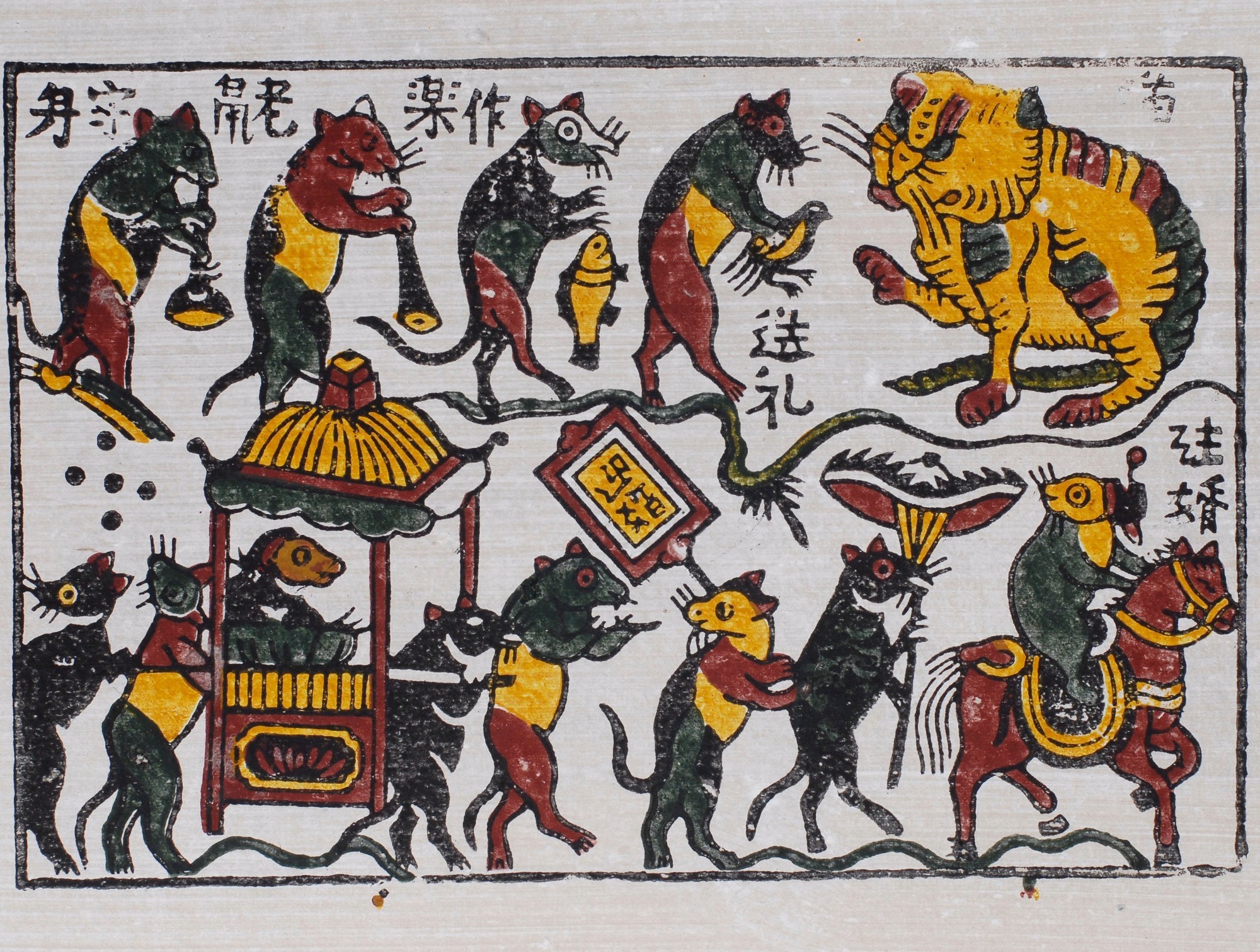
On the surface,the picture depicts a cheerful and imposing wedding between two rats with trumpets, flags, a sedan chair for the bride and a horse and a parasol for the groom, accompanied by the relatives of two rats.
“The Rat’s Wedding” (Đám cưới chuột) is one of the most renowned painting of Dong Ho Folk Painting. A closer look at the painting reveals the rats’ terror and an old cat snarling and raising his paw to threaten the rats... This conveys a satirical message and condemns the corruption issue among the ruling class of the past society.
YIN AND YANG PIGS
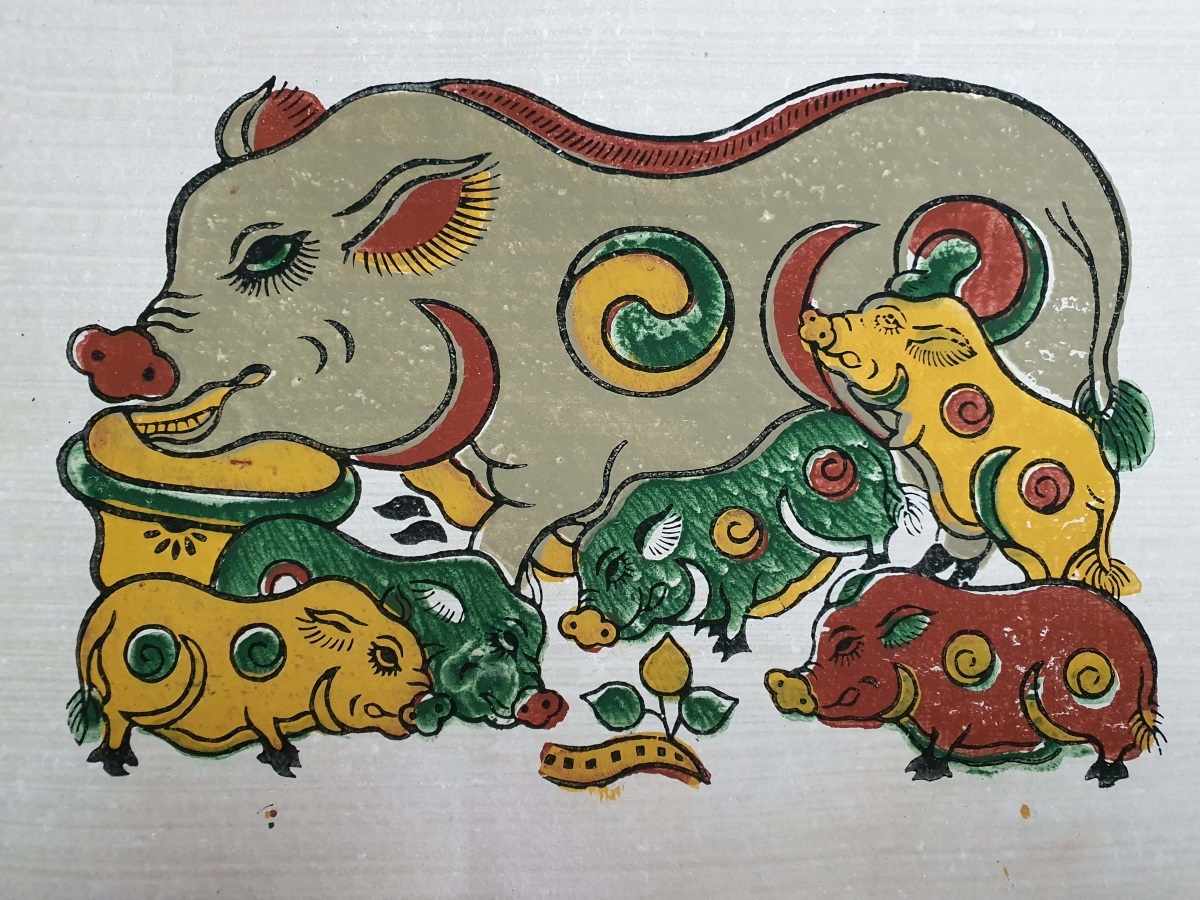
“Yin and Yang Pigs” (Đàn lợn Âm Dương) have a robust expression but are also soft. Each pig has yin and yang circles, a way to tell people’s wishes, which is the harmony between earth, sky, humans, animals, and nature. The desire for abundance and proliferation of life is like the crowding of pigs. The picture brings happiness, affluence, and a happy and harmonious family.
Pig herd painting shows a herd of piglets gathering around the mother pig, each with a different look: they want to climb on the mother's back, they want to snuggle into the mother's belly, the others are facing the leaf buds potatoes to eat... with a strong, simple layout, rich in stylized decoration, but rich in realism. It contains the farmer's wish for increased production, a prosperous life, harmony, happiness, and a full flock of children and grandchildren.
On the pig's body, there are two yin and yang vortices that both create tangible beauty and contain the concept of the five elements. Next to it is a herd of piglets gathering around the mother pig. Decorative images are harmoniously combined. Forming a tight rectangle without being dry, it exudes a crowded, warm look.
On Tet holiday, people will draw a yin and yang circle on "Mr. Pig"'s body to sacrifice to the God. In addition, pigs in folk culture symbolize money and are a great asset of the family. Pigs also symbolize carefreeness, comfort, solving things quickly and more conveniently.
PIG EATING TARO LEAF
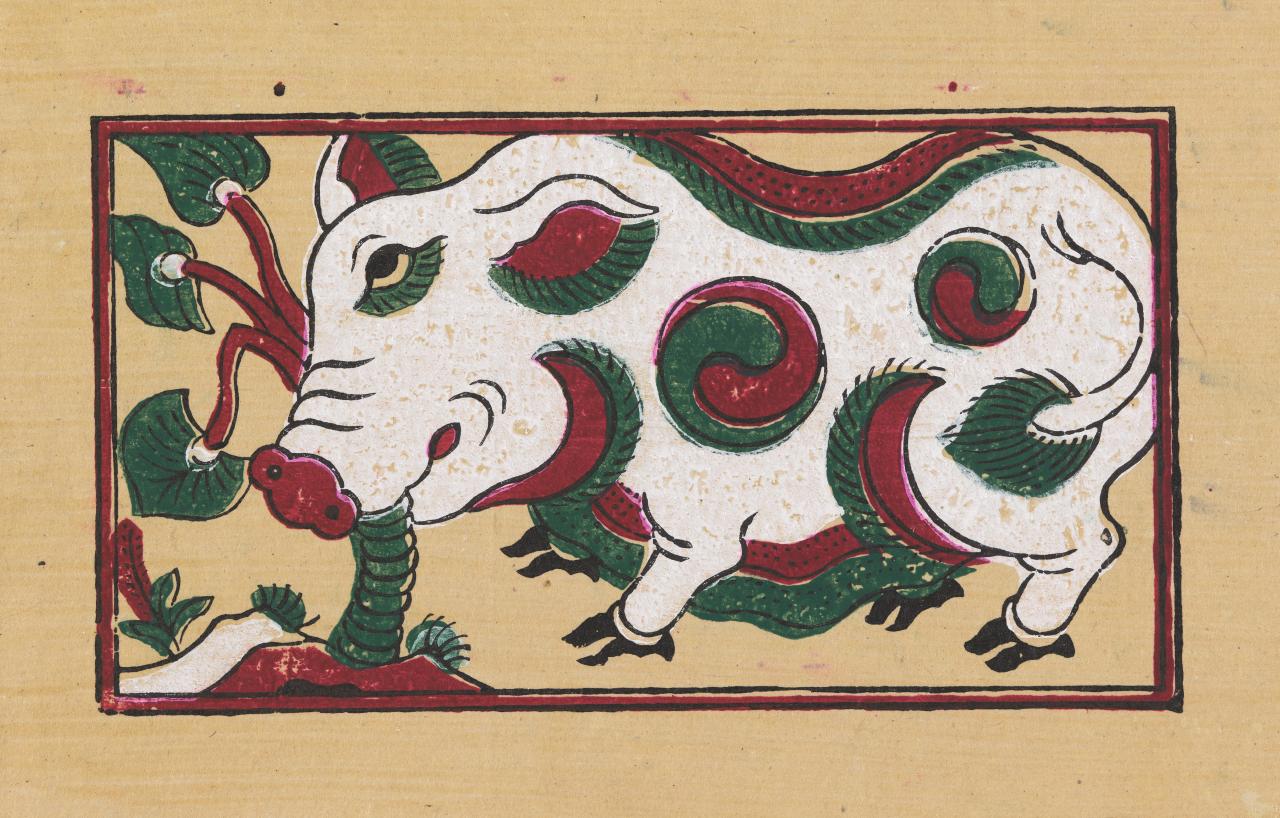
Pigs reproduce at a high rate, hence their image is popularly used in folk art to symbolize fertility, good luck, and a happy family with a multitude of descendants, especially in Dong Ho paintings, highly in demand during the New Year.
In real life, pigs may be small and skinny. But in the Dong Ho paintings, they are all plump with a wide mouth, the unmistakable characteristics of a good breed of pigs that eat well and grow very fast.
The gluttony of the pigs is depicted most sharply in the “pig eating taro leaf” painting. Taro is a usual food farmers use to feed their pigs. The pig plunges its whole mouth into the manger, and the taro leaf seems to be moving. The large body of the pig occupies almost the whole picture, its tail curleds up, the ears raised, and the four legs form a strong stance to push ahead for a bigger bite and to pull the taro branch back to hold more of it.
The “Pig eating taro leaf” (Lợn ăn cây ráy) painting express simple dreams of the country people. They work hard to grow the pigs, and they want their pigs to grow big, fat and fast. The image of a pig can be used as a symbol of financial wellness.
BABY HUGGING A CARP
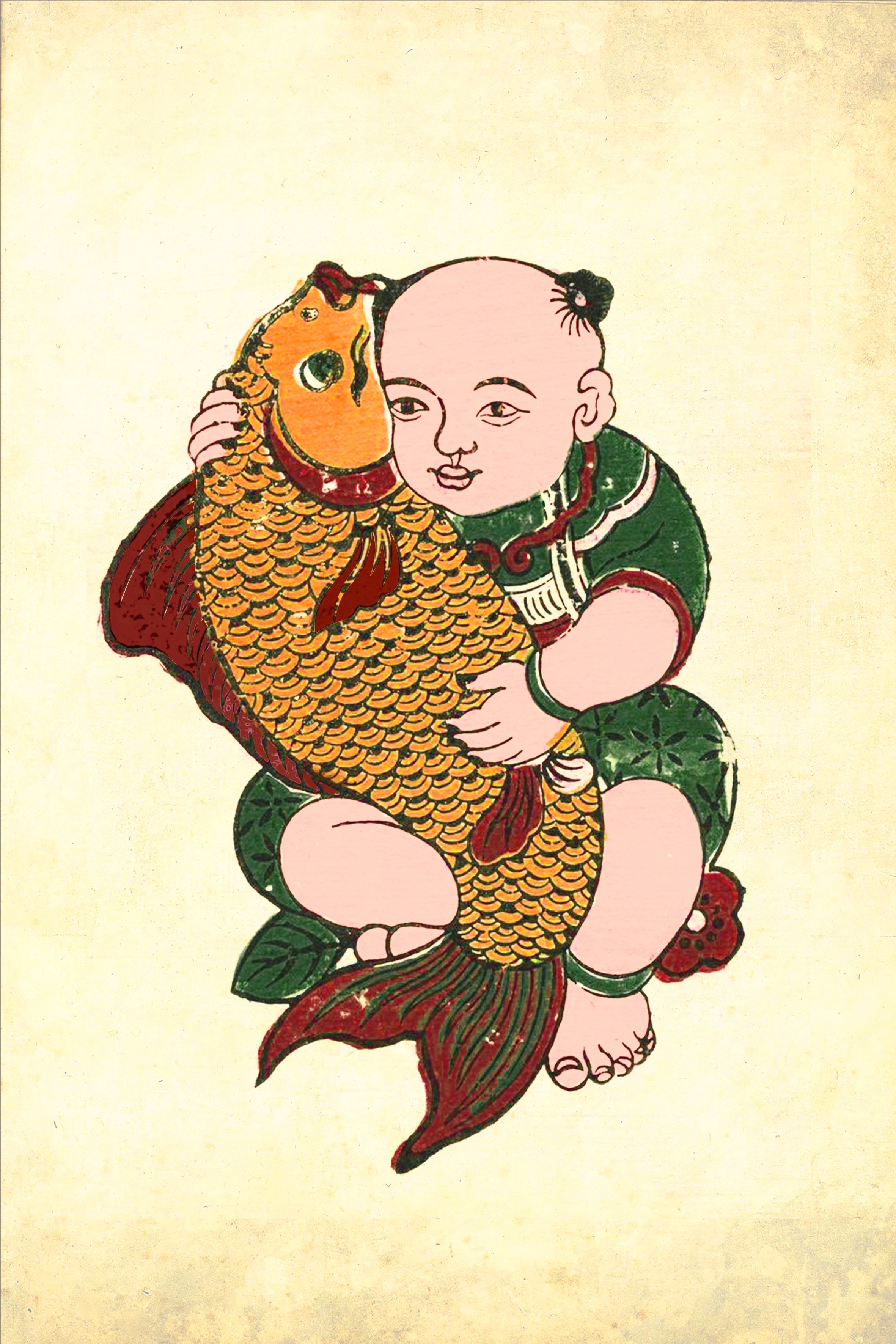
“Baby hugging a carp” (Em bé ôm cá chép) represents the joy of holding a plump carp in the new year. The image of Fish in Vietnamese folk culture symbolizes letters, learning and career advancement. Besides, Carp is not only a symbol of education and fame. It is also a symbol of a rich, prosperous, and abundant life. Paintings are often hung during Tet.
Carp is a very good jumping fish that can jump over the dragon gate to transform into a dragon, it will also symbolize promotion, promotion at work and perseverance to achieve success. In addition, in Chinese, fish is called "fish" - whose pronunciation is "Yu" which sounds the same as "du" 餘 (meaning abundance) and fish drawings are often combined with many other patterns that can understood as "residual" means "to have", that is, to be rich: surplus to eat, surplus to spare. Therefore, Carp is considered a symbol of money and fame.
CARP LOOKING AT THE MOON
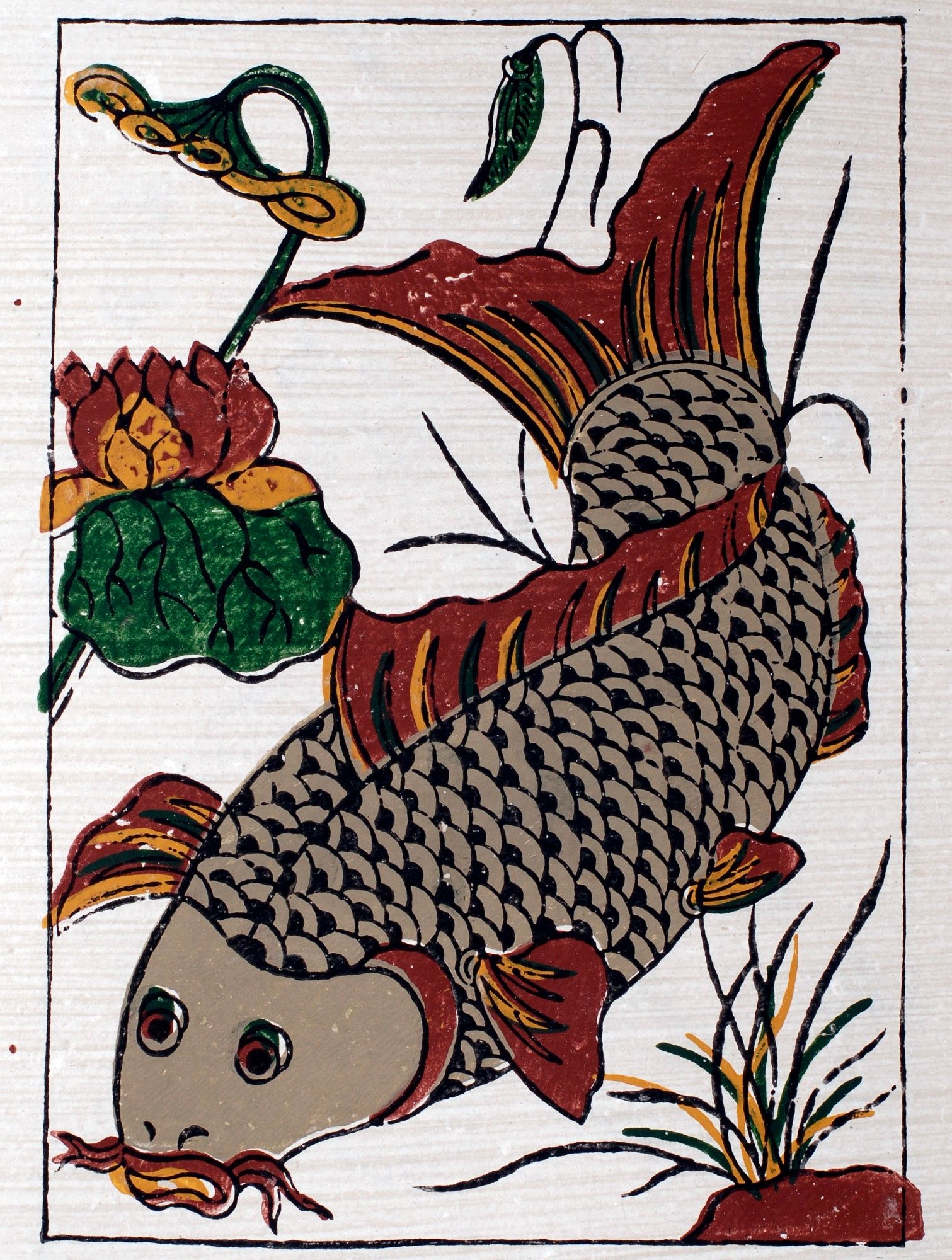
The image of Carp - the main subject in the painting has been known for many generations in connection with the legend "The carp crossed the martial arts gate and turned into a dragon". Therefore, it has no small symbolic meaning in life, in the field of career, study and exams. Carp is a symbol of consciousness and determination to rise up, overcome all difficulties and challenges in life, it is a symbol of the will to progress of kings and heroes, and is also the wish of countless people.
The image of the moon in the painting is depicted in its most beautiful state. That is the image of a bright, full, perfect moon, and is also a symbol of completeness and fulfillment. Since then, the image of the moon carp has created a special meaning for the whole picture - it symbolizes the wish to have a full, fulfilling life, enjoy good things, and have good luck on earth. career path and education.
The painting “Carp Looking At the Moon” (Lý ngư vọng nguyệt) shows the desire to succeed in study, fame, and career. The desire for the image of a carp comes from the belief in folklore that a carp crossing the heaven gate will turn into a dragon, like a student overcoming difficulties to achieve success.
LITTLE BUFFALO BOY PLAYING FLUTE
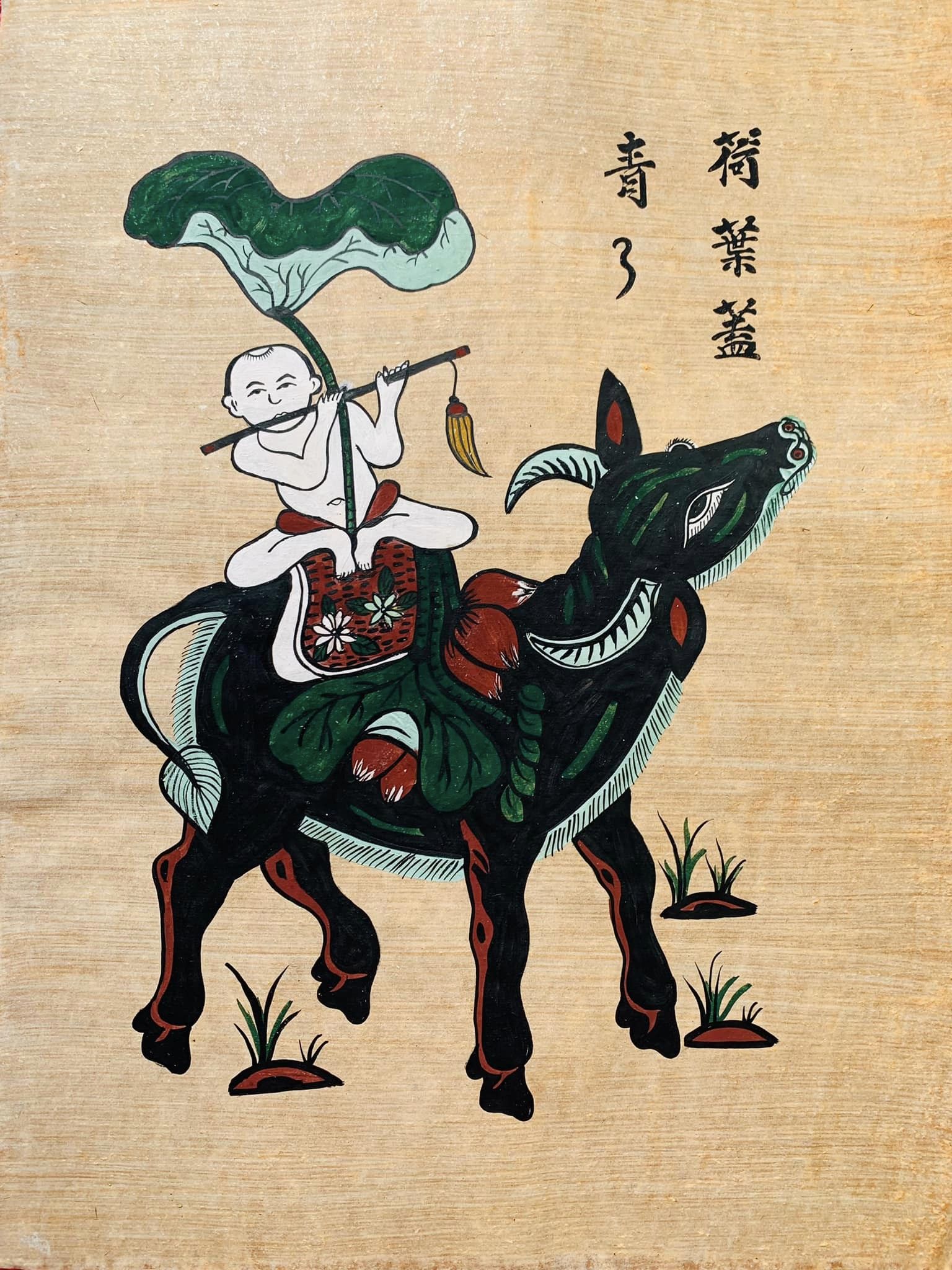
To Vietnamese farmers, buffalos are the most valued possessions. In the painting, the buffalo pricks its ears, moves its feet to the sound of the flute and wag its tail happily. It seems that the buffalo also enjoys the music and feels as happy as the boy does. Besides farm work, buffalos are true friends of the farmers who go through all the ups and downs with them. The painting also praises clever little boys for helping their parents in the fields.
The painting represents the wish for "favorable weather - favorable land - harmonious people" to always have good harvests because Vietnam is associated with wet rice cultivation.
The buffalo symbolizes honesty and kindness. The buffalo raises its head to show a stable atmosphere, not wanting to compete with life, but still has the will to strive, relying on its own abilities to achieve the set goal.
JEALOUSY
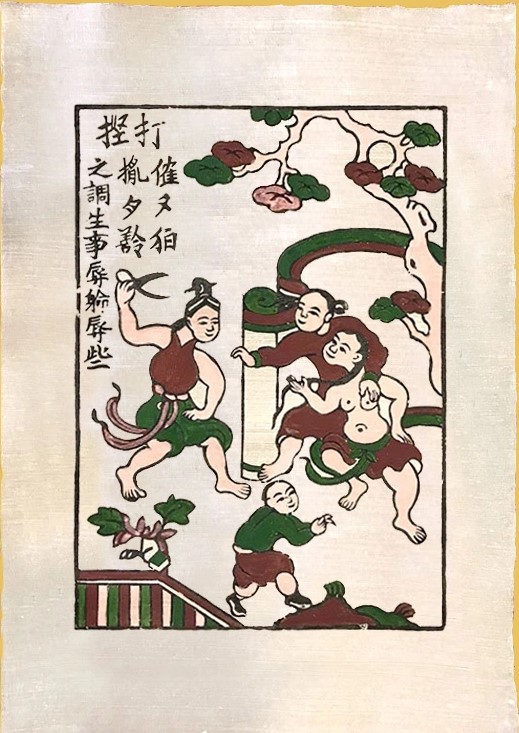
Under the feudal system, women must obey ethical behavior. The painting represents the aspiration and resistance of women under Confucianism. The caricature is expressed in the exaggeration of the shapes and lines in the picture, which creates the humor and the excitement before a family tragedy. With Jealousy Scene, we can see the static and dynamic elements are harmoniously combined. The static elements in the painting are a pine tree, bonsai, and a flower wall. In contrast, the dynamic is two wives pulling each other drastically between the husband and the child.
Family relationships are one of the topics reflected in the paintings that are quite profound and witty. Under feudalism, men were allowed to have "five wives and seven concubines". This polygamy regime created inevitable family conflicts. "Jealousy" (Đánh ghen) is a typical Dong Ho folk painting of this topic.
PICKING UP COCONUTS
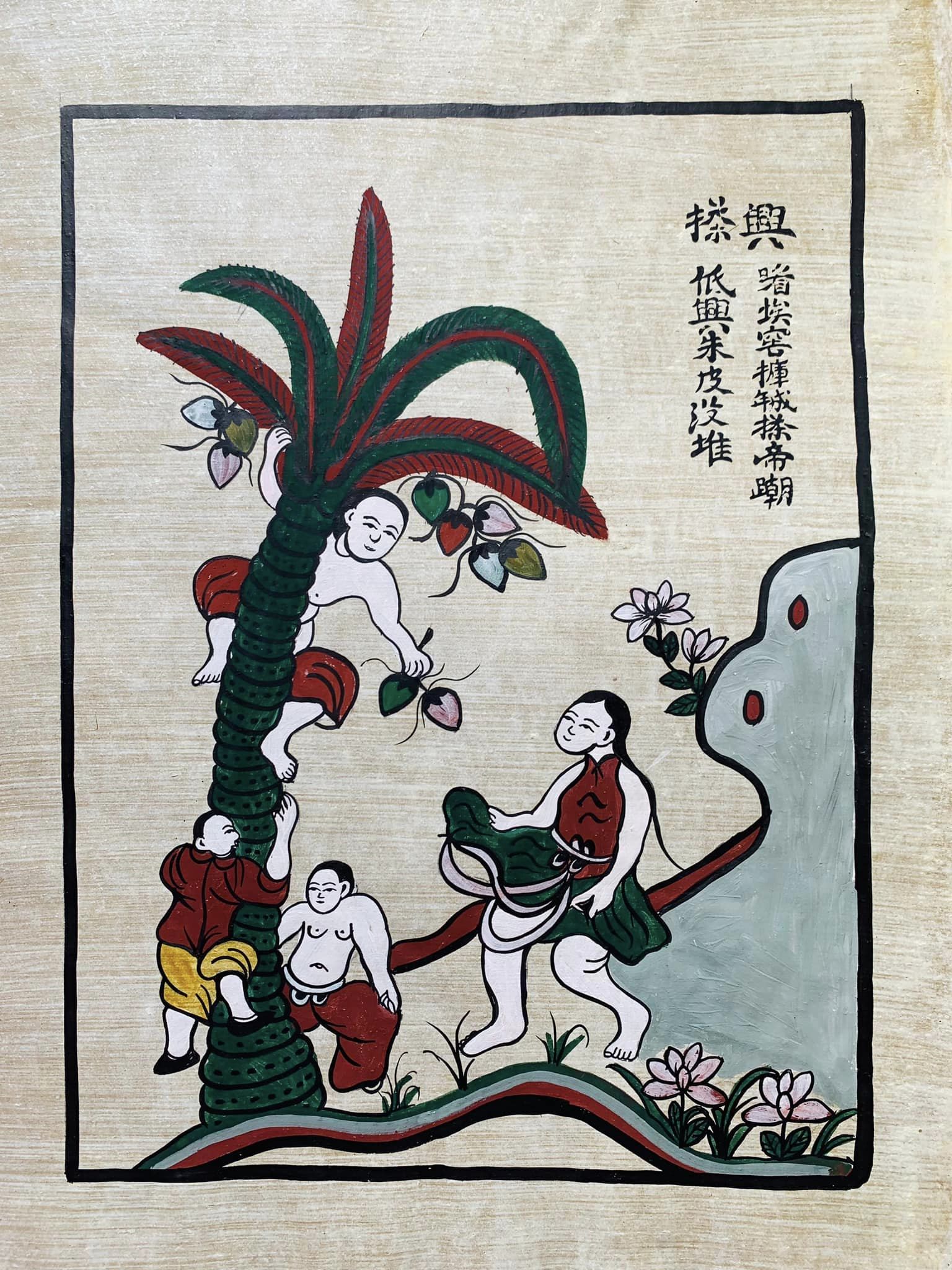
The painting expresses the concept of a happy family in a country including a wife, a husband and two children. The husband with the difficult job is to climb up the coconut trees as breadwinner , who has a career and bravely overcomes all the challenges. The wife is picking coconut as the rear, who always supports her husband when necessary. In the painting, she does not use the hand but the skirt to pick up the coconut, which makes the scene funnier. The children cling to the tree as if they want to share the hard work or to imitate the father overcoming all dangers.
The painting “Picking Up Coconuts” (Hứng dừa) looks simple but gentle, and it conveys the meaning of family reunion, harmony, sharing, and helping each other in life. A family is the fundamental cell of society, in which the husband and the wife always love and help each other. They also have good children who sympathize with the struggles of their parents.
CHICKENS FAMILY
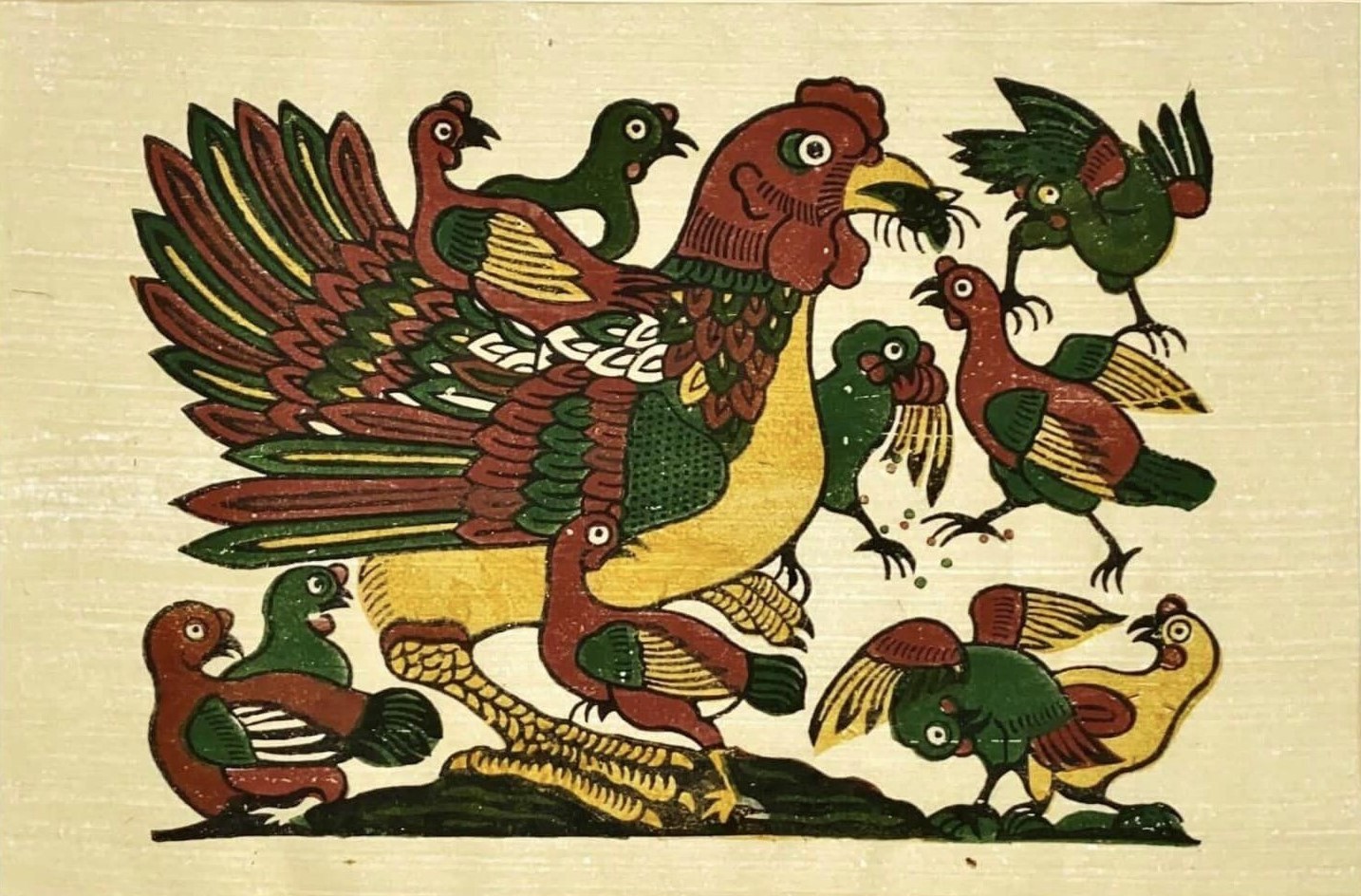
The painting features a hen surrounded by ten baby chickens, each is different in the gesture and posture but all are very playful and energetic. The principal hue of the artwork is made up of warm colors, making it brighter with a sky full of sunlight. The painting stands for the farmer’s dream of fertility and happy families.
Hens in Vietnamese people's subconscious are associated with sacred, warm maternal love, ready to spread their wings to protect their chicks. In addition, the image of a chicken signaling good luck, is a symbol of family harmony and prosperity.
ALARMING ROOSTER
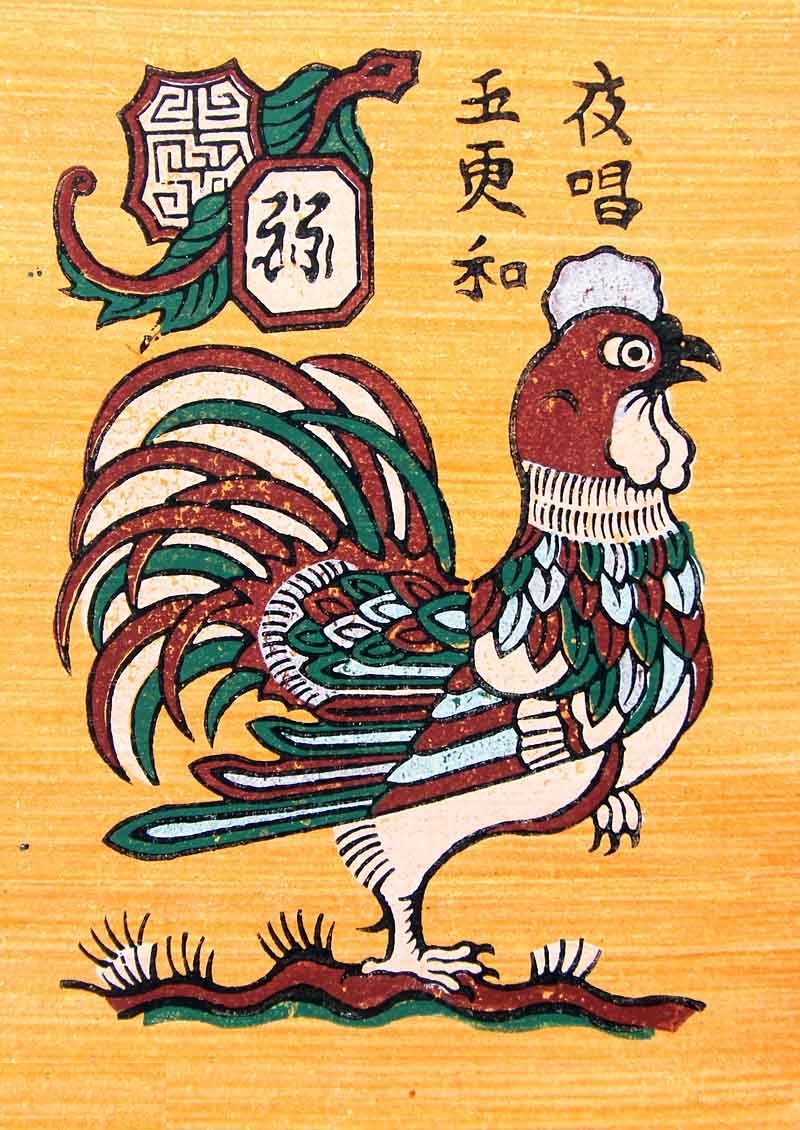
The picture is about a rooster calling to the sun, dispelling the dark night. Like driving away evil spirits, evil spirits, it brings good luck, excitement for the new day, for the new year. The precious virtue of the rooster is the word "Trust". The word “Trust” shown in the picture has a very noble meaning.
The colors used in the painting, including red, blue and yellow feathers, are subtly coordinated, creating an impressive beauty and vitality for the rooster. The posture of the rooster is also shown firmly and professionally, showing its confidence and strength. Every day, the rooster always crows at the beginning of a new day , no matter how windy or rainy it is. The rooster is a close friend of the villagers, always waking everyone up on time with its majestic crowing.
PEACEFUL WORLD
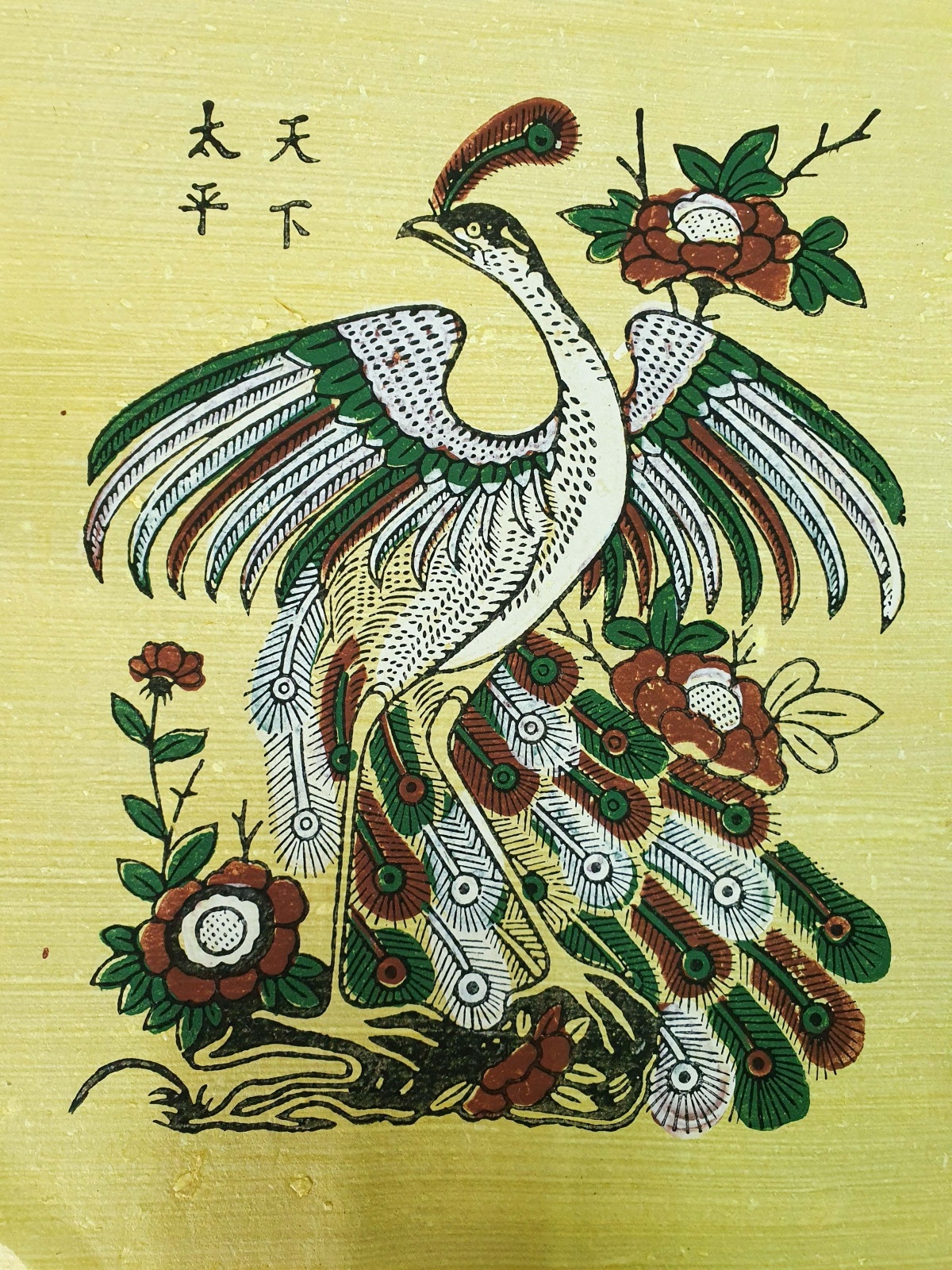
Peacocks impress viewers with their beautiful feathers. Peacock feathers have iridescent colors, spreading out in a beautiful fan shape. On the peacock feathers, there are countless patterns that look like connected coins. Every time the sunlight shines on them, they become even more sparkling and prominent.
The artwork named after the letters printed on it, features a peacock. The Peacock spreading its wings symbolizes nobility and prosperity. The image of a peacock is a symbol of beauty and strength. Many people believe that hanging peacock paintings in the house will ward off evil spirits and bring good luck to the family.
BUFFALO HERDING AND FLYING KITES
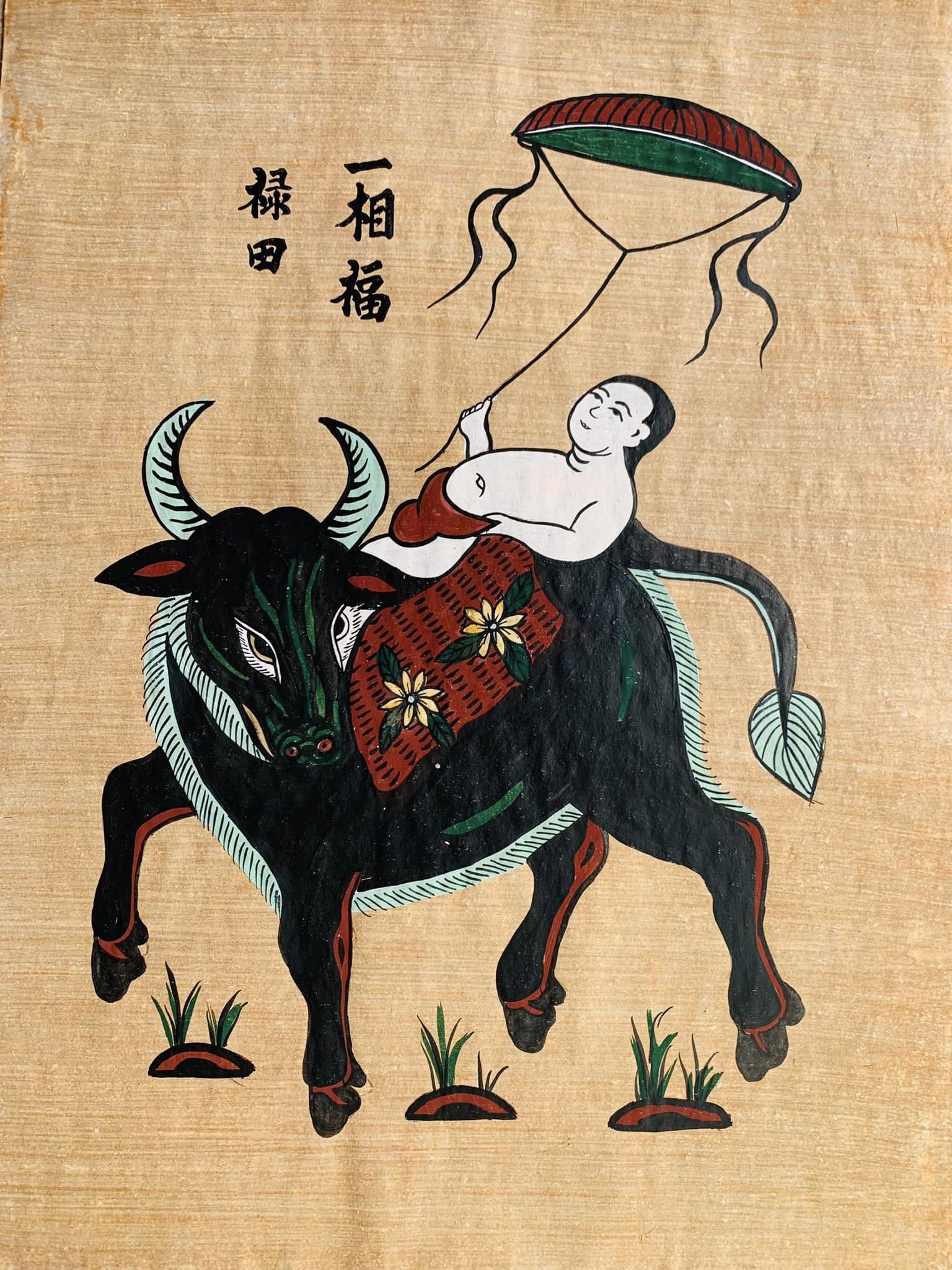
The painting "Buffalo herding and flying kites" (Chăn trâu thổi sảo) is the image of a boy lying on his back on the back of a buffalo and flying a kite. The buffalo in the painting has its front legs lifted up as if it wanted to fly with a kite. The parasol and belly are full, representing the farmer's wish for a peaceful life full of blessings.
Painting of a buffalo herding a kite with the words: Nhat Tuong Phuc Loc Dien (The best harvest for the people), the buffalo is walking slowly with its head turned to one side and looking straight ahead, its eyes bright, its horns raised like a new moon , a child spreads a mat on the back of a buffalo tied with a few chrysanthemum branches, lies naked in a loincloth and lies on his back looking at the sky, his right hand holds tightly to the string of a wind-filled kite flying high above his head, reminding the viewer of a fairy tale.
The buffalo bowing its head has a more humble meaning, showing harmony, patience, and a bit of humility.
EMINENCE
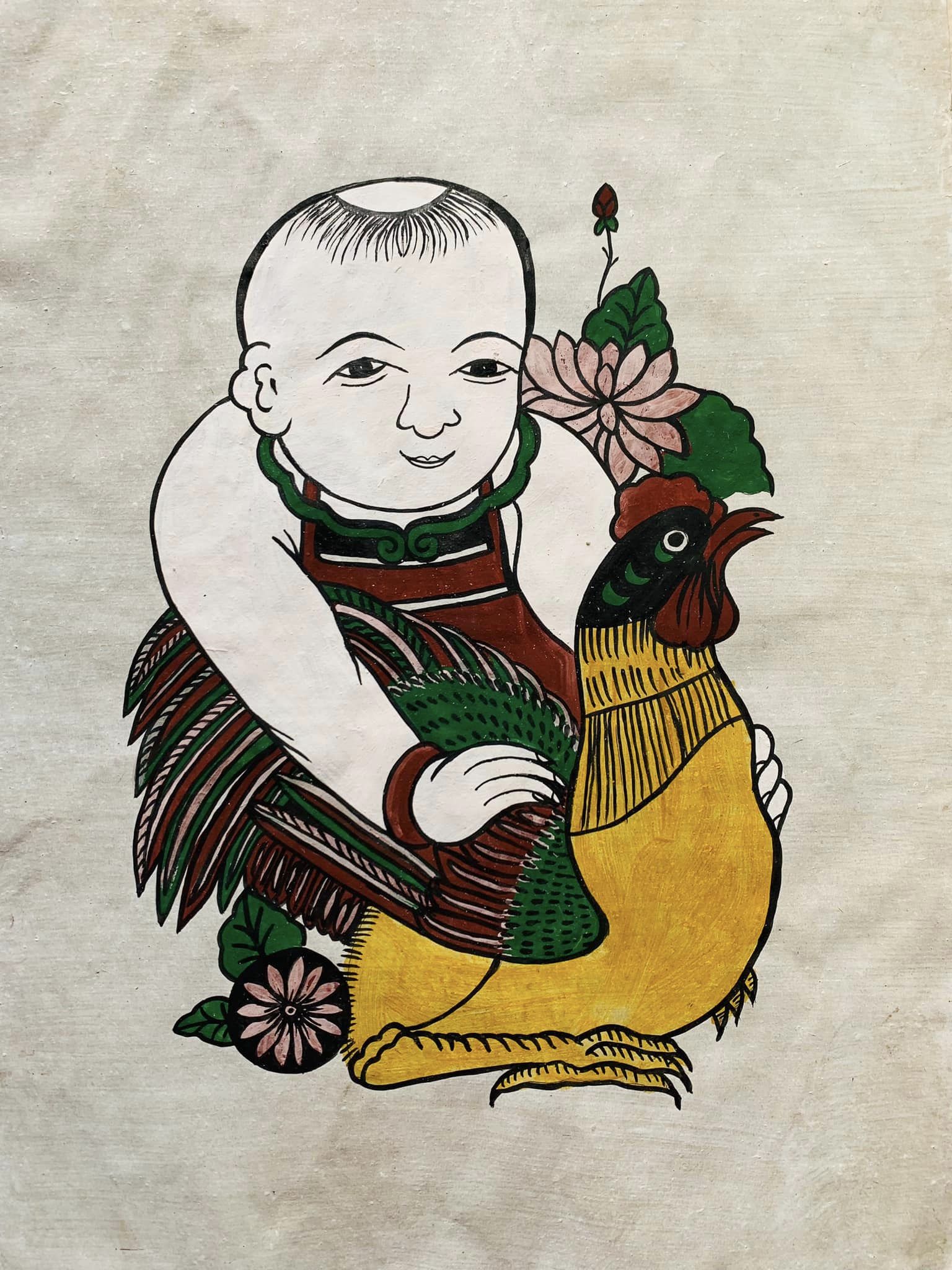
The big rooster in Chinese is read as "Dai Ke" which is the same as "Dai Cat". It implies bringing wishes of great fortune and prosperity to the family. In addition, the Rooster is also a symbol of courage and five precious human virtues.
A plump boy holds a rooster with a pot of chrysanthemums blooming behind him expressing the wish to procreate, the wish to give birth to a healthy boy. Later, when he grows up, he will become a successful and glorious person. And has all 5 precious qualities is Humanity - Righteousness - Ceremony - Wisdom - Trust.
“Eminence” (Vinh Hoa) painting is often hung in the living room with the meaning of bringing good luck, favorable conditions in business and trade, quickly achieving fortune, great auspiciousness, and great benefits. A gifts for families who have just given birth to a baby boy to express wishes that the baby will be healthy, plump and have valuable qualities.
PROSPERITY
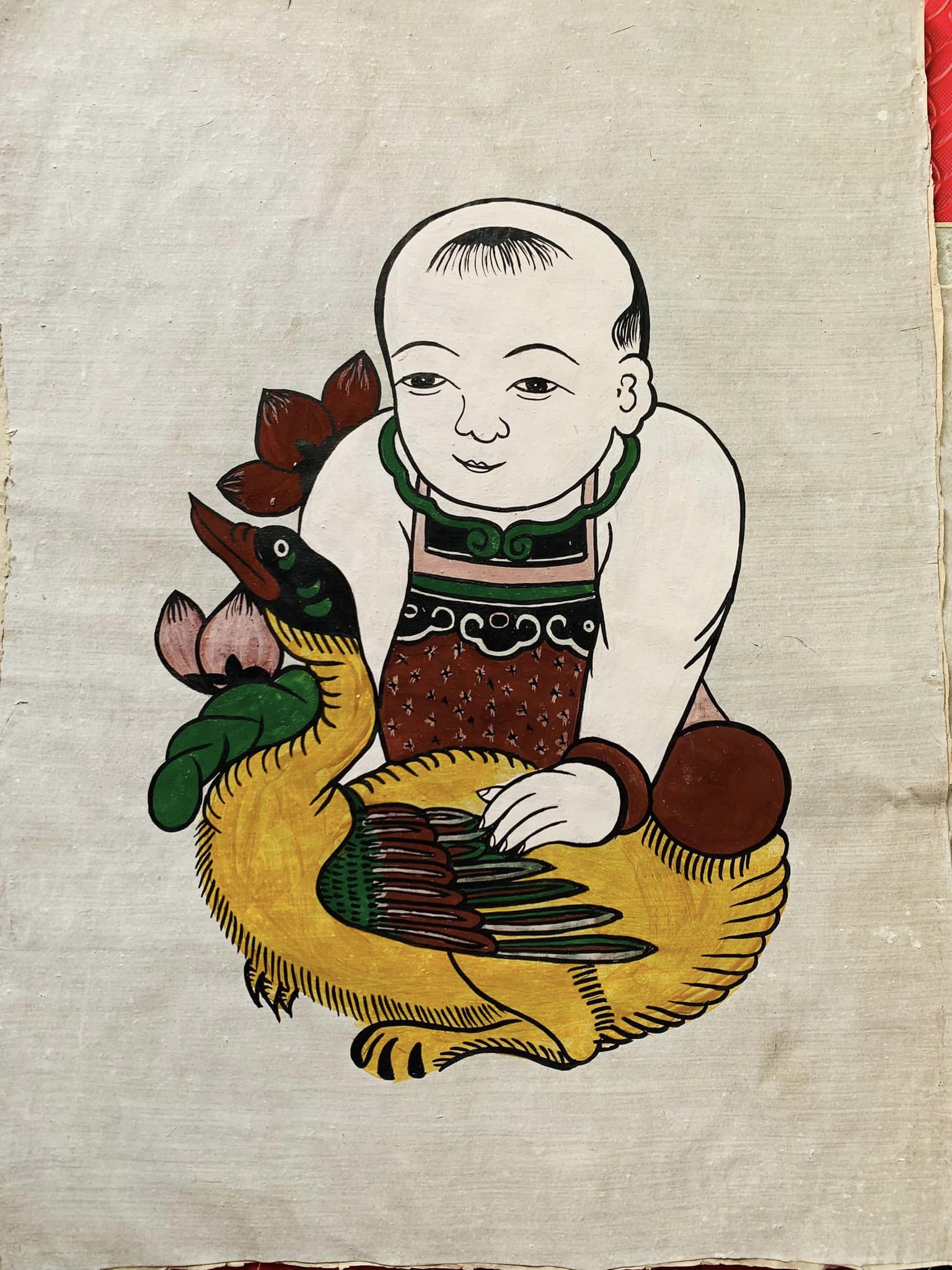
The picture of a little girl holding a duck with a round, lovely face, radiant, happy and healthy expression. Express your wish to give birth to a gentle, charming, intelligent, and agile baby girl. The Duck symbolizes prosperity. Although ducks lie subdued, they still hold their heads high to express themselves the desire to rise in life.
“Prosperity” (Phu Quy) paintings symbolize luck, fortune and wealth, so people have the saying “tai loc sung tuc”(wealth) or “tai loc cat tuong "(prosperity)
BUFFALO FIGHTING
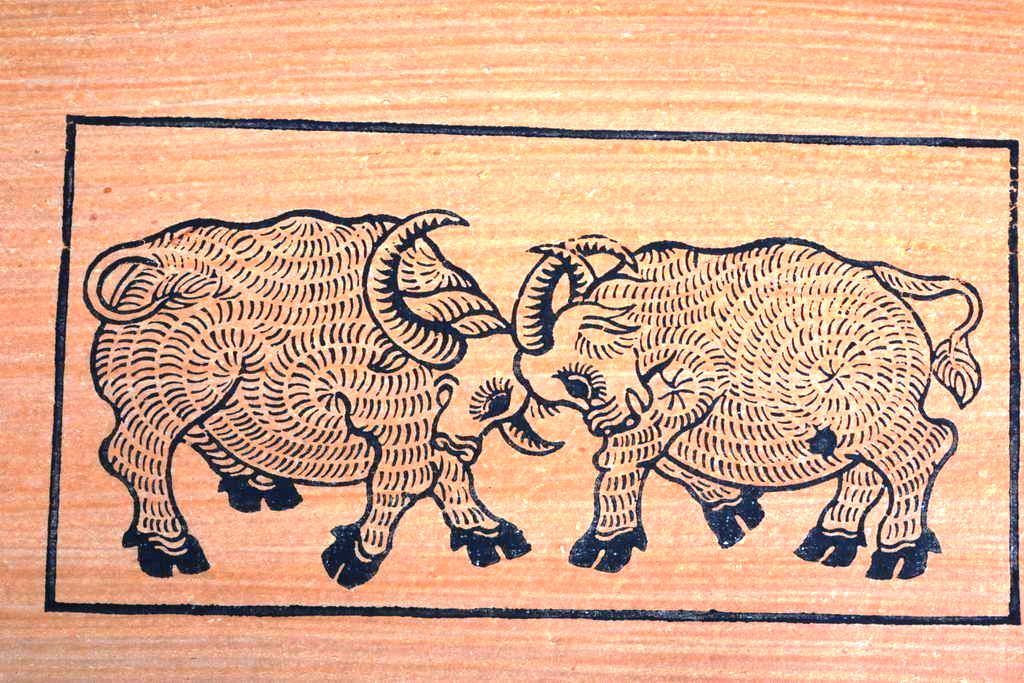
The Viet were traditionally an agricultural people living mainly off wet rice, which of course. And since time immemorial, the water buffalo has helped farmers with the most physically demanding tasks: tilling the land and towing the harvest. From that starting point, it has come to represent the rustic Vietnamese. The buffalo fighting competition represents the farmers' dream of a peaceful life.
The proverb “con trau la dau co nghiep” (the buffalo is the prerequisite for starting a business) stems from this practice, suggesting this animal was the cornerstone for a prosperous society.
The buffalo raises its head to show a stable atmosphere, not wanting to compete with life, but still has the will to strive, relying on its own abilities to achieve the set goal.
The buffalo bowing its head has a more humble meaning, showing harmony, patience, and a bit of humility. The buffalo bows its head to invite fate, increase noble energy, expand relationships, and create noble destiny for itself.
OLD FARMER RESTING
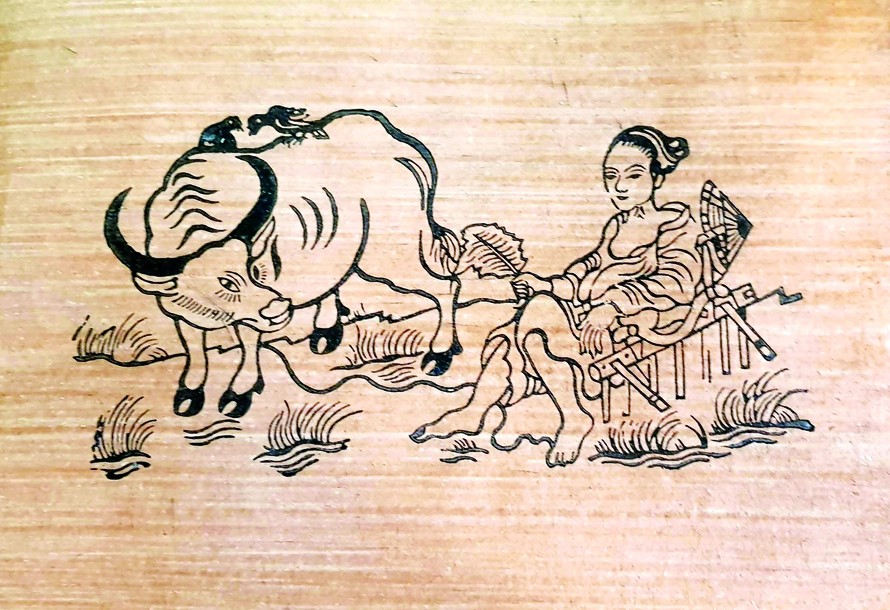
The painting shows a farmer resting after harrowing the fields. Here the artist comments on the meaning of the painting as follows: «The world is peaceful and the people are happy»
This painting is not only for the purpose of making farmers happy, but also as a wish for a peaceful new year and a happy rest. In addition, it has a buffalo next to the farmer to increase happiness, luck as well as health and bring abundant wealth.
CARPS
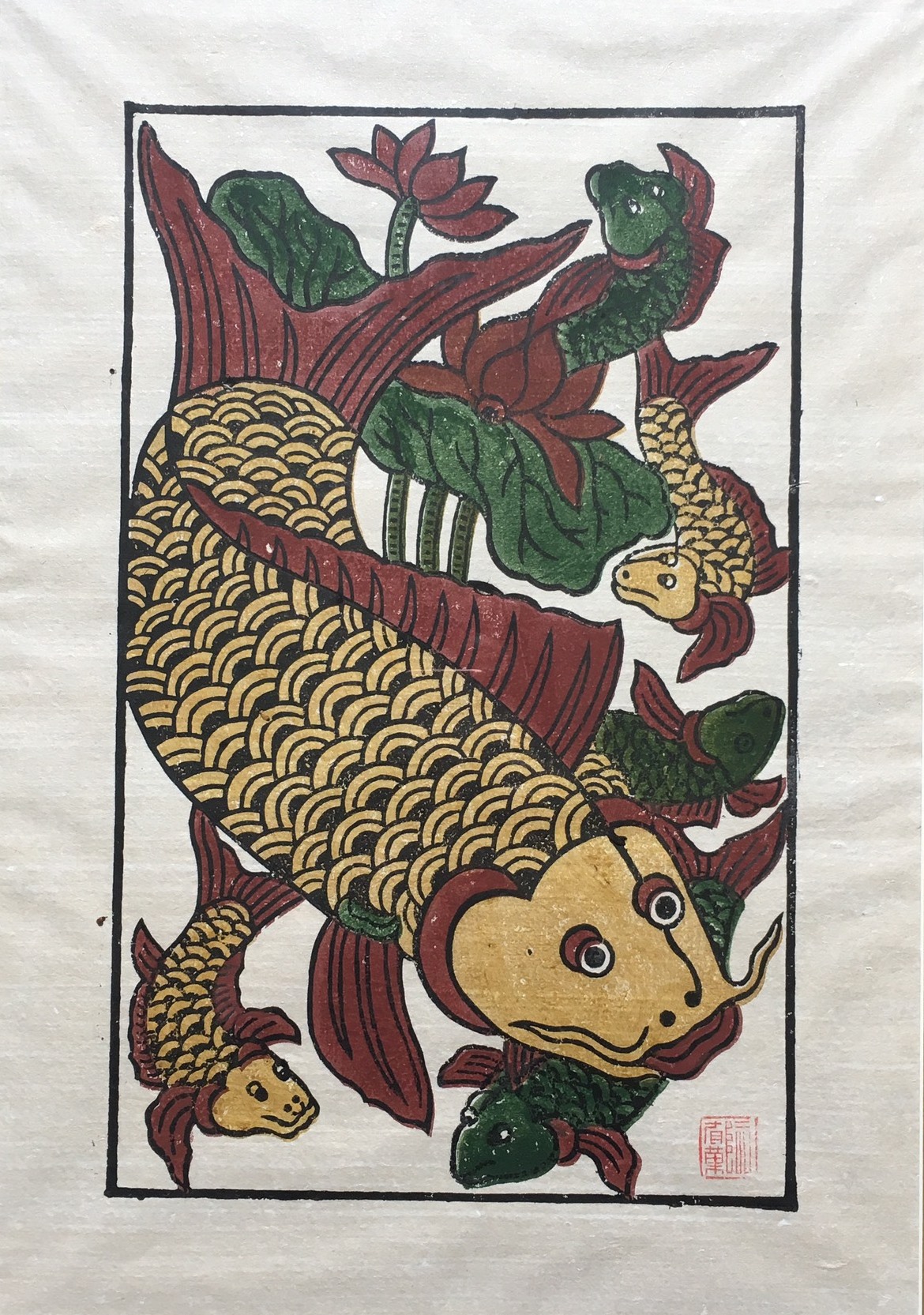
The image of Carp - the main subject in the painting has been known for many generations in connection with the legend "The carp crossed the martial arts gate and turned into a dragon". Therefore, it has no small symbolic meaning in life, in the field of career, study and exams.
Carp is a symbol of consciousness and determination to rise up, overcome all difficulties and challenges in life, it is a symbol of the moving spirit of kings and heroes, and is also the wish of countless people.
It is a popular painting during the Tet Holiday, which represents the wish of good luck and fortune. In the Oriental culture, legend has it that carp are capable of jumping over the Dragon Gate to transform into dragons. Thus, carp is a symbol of supreme effort, fortune, success and hope.
DRAGON PROCESSION
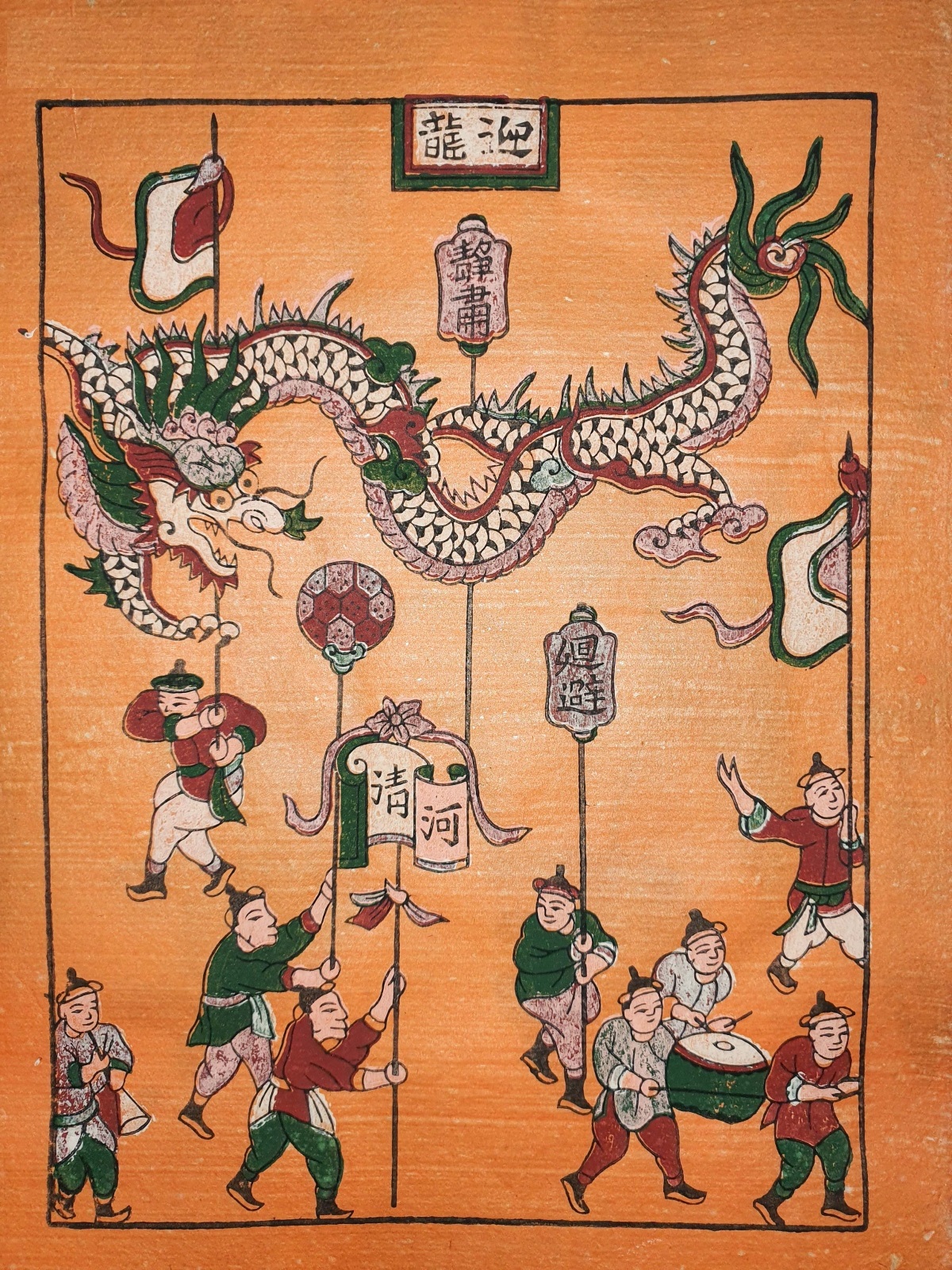
The Dragon has become a mascot of the Vietnamese people for years that is associated with the fairy tale of “The Dragon and the Fairy” of the Vietnamese nation. The Dragon is also a symbol and represents both the authority of nature as well as in society. The painting shows a scene of a dragon dance during the Spring Festival.
The Dragon is also a familiar symbol to the residents of the rice civilization in East Asia and represents both the power of nature and society. The Dragon Dance is a performance combining dexterity and strength popular among residents in East Asia and places with Chinese communities. In Vietnam, in addition to the Dragon Dance, there is also the Snake Dance in Le Mat village (Gia Lam) or the Lion Dance (especially during the Mid-Autumn Festival)
Synthetic
Related Articles
Do you want to book another itinerary, start now!
New booking


